
Flag of the Army of the Trans-Mississippi.
The Trans-Mississippi Department was a geographical subdivision of the Confederate States Army, formed May 26, 1862, and comprising all territory of the Confederate States west of the Mississippi River: Missouri, Arkansas, Texas, Indian Territory, and Louisiana. The combined department had its headquarters at Shreveport, Louisiana, and Marshall, Texas. After a series of botched raids into the Union Territories of Arizona and New Mexico in February-April 1862, the bulk of the Department was reorganized as the Army of the Trans-Mississippi on September 28.
The Trans-Mississippi was the last active CS land force of any note. Its existence ended when General Edmund Kirby-Smith surrendered to the United States Army on May 26, 1865, a month after all other major theaters of the American Civil War had ended.
Trans-Mississippi Department in Southern Victory[]
After the War of Secession ended in October 1862, the Confederate Army assigned the Trans-Mississippi Department to patrol the Confederacy's borders with the United States and the Empire of Mexico. The Department's first major operation took place in 1874, when Comanches from New Mexico Territory launched a series of coordinated raids against Texas. Thanks in part to the efforts of the Confederate Camel Corps, which could go places that horses couldn't, the Comanches were quickly put down.[1] In 1879, General Jeb Stuart took command of the army, moving its headquarters from the traditional home of Houston or Austin to El Paso.
In May 1881, the army was ordered to move troops into position to take possession of the Chihuahua and Sonora. General Stuart organized five regiments of cavalry, half a dozen batteries or artillery, and three regiments of infantry. On June 14, the army moved into Paso del Norte to formally take possession of the two new provinces, igniting the Second Mexican War.
The Trans-Mississippi Department led only one offensive operation against US territory. Although General Stuart was aware of President James Longstreet's defensive strategy, he believed that the best way to defend the new territories was to make the Yankees defend their own. Although communications from Richmond were sketchy at best, Stuart heard no word of reproof from the War Department in regards to his plans, so he marched into New Mexico Territory as soon as the declaration of war reached him.
The campaign got off to a promising start when he managed to hoax the US commander at Contention City, which impressed the Apaches under Geronimo, leading to an alliance between the two forces. After this, they successfully lured US forces into an ambush at the Battle of Madera Canyon before fighting the Battle of Tombstone. Now having cleared the territory of all US Forces, they returned to CS territory where they dispatched US raiders with the Camel Corps, whose camels once again allowed the Confederates to operate with much greater range. With no opposition left, the New Mexico front remained quiet, until tensions between the Apaches and the CSA's new Hispanic subjects led to a vicious war between the Apaches and the CSA in 1882. General Stuart perished in this conflict.
References[]
- ↑ How Few Remain, pg. 47, mmp.










